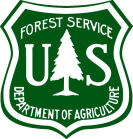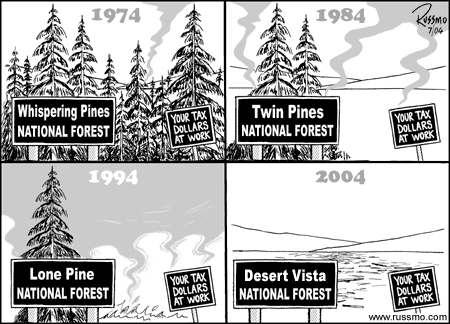|
|
Forest Service |  |
|
|
||
|
|
||

|
||
|
"And now, first and foremost, you can never afford to forget for a moment what is the object of our forest policy. That object is not to preserve forests because they are beautiful, though that is good in itself; nor because they are refuges for the wild creatures of the wilderness, though that, too, is good in itself; but the primary object of our forest policy, as of the land policy of the United States, is the making of prosperous homes. It is part of the traditional policy of home making in our country. Every other consideration comes as secondary. You yourselves have got to keep this practical object before your minds: to remember that a forest which contributes nothing to the wealth, progress, or safety of the country is of no interest to the Government, and should be of little interest to the forester. Your attention must be directed to the preservation of forests, not as an end in itself, but as the means of preserving and increasing the prosperity of the nation." - President Teddy Roosevelt, speaking to the Society of American Foresters in 1903. (emphasis added)
“It is probably a healthy exercise, when considering the extinction of species in this age, to remember that many thousands of life forms have ceased to exist from wholly natural causes -- dinosaurs spring invariably to mind. And further that some organisms -- especially primitive forms, which, as it were, are ‘past their prime’ -- will pass into oblivion, both without human assistance and in spite of it.” - from The Birdwatcher’s Companion, page 229, authored by Christopher Leahy of the Massachusetts Audubon Society, 1982.) Forest Health – A measure of the robustness of forest ecosystems. Aspects of forest health include biological diversity, soil, air, and water productivity; natural disturbances; and the capacity of the forest to provide a sustaining flow of goods and services for people. – Daniel Boone National Forest Glossary of Terms http://www.srs.fs.usda.gov/r8/boone/documents/planning/revplan/glossary.pdf (Page 5 of 18 pages; 158.92 KB) [emphasis added]
|
||
|
|
||
|
Area
of Potential Effects – The geographic area or areas within which an
undertaking may cause changes in the character or use of historic
properties, if any such properties exist.
– National Grassland Plan (USDA Forest Service) http://www.fs.fed.us/ngp/draft/plan/pdf_plan_draft/Dakota_Prairie_Plan/Appendice s/appendix_g.pdf |
||
|
|
||
|
Forest Health

http://www.russmo.com/04_07_20.html Use of Russmo Toons The images appearing on the Russmo Website are low resolution gifs designed for online viewing. Permission is hereby granted to download, copy, forward or post on other Websites, provided that the artwork is not altered in any way. Though it is not
required, we appreciate being informed when the cartoons are used on
other Websites or if a link is created to Russmo.com. This is helpful
for networking purposes and for tracking where our new readers are
coming from. For information on higher quality art suitable for print publication: http://www.russmo.com/PDFArt.html |
||
|
|
||
| The smoke from the fires is getting into the Rouge Valley where I live and choking us half to death. My eyes burn, I'm doing a lot of sneezing, and the sky looks like chocolate milk. It is a repeat of last year's conflagrations. - Oregon rural resident, September 3, 2003 | ||
|
|
||
| "Even OHV -- Off-Highway Vehicle -- use alone affects more imperiled species than logging and logging roads combined." - Dale Bosworth, Chief, USDA Forest Service, in a speech he made on April 22, 2003 at the SF Commonwealth Club. | ||
|
|
||
| Vertical Mulching - A high priority recovery need for the federally-listed desert tortoise and other sensitive species occurring within the California Desert is the restoration of unauthorized routes, or road reclamation (refer to West Mojave Route Designation, Ord Mountain Pilot Unit, Biological Resource Screening Components; Bureau of Land Management 1997). Such restoration allows for the protection of large contiguous blocks of habitat that are relatively unencumbered by vehicle use impacts and related activities. Restoring unauthorized routes would significantly reduce identified habitat fragmentation occurring within designated tortoise critical habitat units and yield tremendous positive benefits affecting recovery of this species. Of the 22 major threats to the tortoise identified in recent research, ten would be significantly reduced by restoring unauthorized roads and trails, including the following: fire, off highway vehicle recreation, animal collection, garbage and litter, handling and manipulation, invasive weeds, noise, vandalism, predation (by ravens and similar subsidized predators), and non off-highway vehicle recreation. The Barstow Field Office of the Bureau of Land Management is currently seeking support among potential cooperators to use “desert tortoise habitat compensation” funds for road and trail restoration. Such funds are occasionally generated, pursuant to guidelines in BLM’s Desert Tortoise Rangewide Plan, when habitat-impacting projects are approved within the range of the tortoise that cannot be fully mitigated on-site. In the past, these “habitat compensation” funds have typically been used to acquire private inholdings within designated tortoise critical habitat units. Recently, however, the Barstow Field Office determined that compensation funds generated by several large-scale projects would enable cooperating agencies to protect/enhance a much larger amount of tortoise habitat if these funds were used for route restoration, rather than habitat acquisition. Both methods of offsite habitat compensation are necessary for long-term recovery of the desert tortoise and other sensitive species in certain critical habitat units, and these options should be carefully evaluated on a case-by-case basis. To accomplish both tortoise habitat restoration and route designation objectives in critical habitat units, BLM staff have developed a reclamation strategy commonly referred to as “vertical mulching.” This technique involves the placement of structure (live vegetation, rocks, dead shrubs and “snags,” bunch-grasses, and various woody material) within the confines of the closed roadway surface, both on the ground surface and in a vertical manner, designed to conform with adjacent vegetation and terrain. Use of this technique is further described below. Discussion: Lessons learned by BLM over past decades have shown that route designation cannot be effectively implemented by simply installing red carsonite “closed to vehicle use” signs on or adjacent to unauthorized routes of travel. Efforts must include encouraging vehicle travel on designated open routes, and making designated closed routes literally disappear into the landscape. To begin this “disappearing act,” decompaction and mulching techniques must be applied to closed routes, extending at least to the visual horizon, especially where the closed routes intersect with other routes. The Barstow Field Office has demonstrated that unauthorized roads and trails can be economically restored through use of vertical mulching techniques. These techniques involve placement of boulders and organic structure, such as live/dead and down vegetation, within the disturbed soil portion of affected roadbeds. Only vegetation, rock and woody structure native to the immediate closed route vicinities are used. The estimated cost for restoring tortoise habitat using this technique is $500 per acre, using current technology. The target restoration areas consist of roads and trails that facilitate a variety of anthropogenic impacts to designated desert tortoise critical habitat. The specified collection and installation of mulching material occurs under the supervision of a qualified natural resource specialist, archeologist, biologist or technician, to ensure a minimization of impacts to biological or cultural resources. Areas adjacent to where route closure/rehabilitation is planned may occasionally be used to gather dead vertical mulching material, in a manner designed to avoid causing local dead and down habitat loss, yet also accomplish restoration objectives. In no circumstances are shrubs that shade animal burrows or that are located adjacent to cultural resources, removed for use as mulching material. However, live and dead vegetation from the immediate region, salvaged from land clearing or road maintenance operations, may occasionally be used as mulching material in such restoration projects. Memorandums of understanding developed between land management agencies and local transportation departments, regarding salvage and storage of native material for this application, can facilitate large-scale projects. The use of pitting, ripping, or other scarification techniques within the confines of route or roadbed soil disturbance is sometimes necessary for rapid site recovery. Such scarification is done with hand-tools or through the use of heavy equipment and machinery (toothed rake, pitter, or similar device pulled by a tractor). After scarification, the live or dead vegetation is placed in a vertical fashion within the confines of route or roadbed soil disturbance, in a manner designed to conform to adjacent terrain and vegetation. The Barstow Field Office is able to restore Mojave Desert habitats for about $500 per acre, due to relationships and agreements it has in place with the California Conservation Corps and other local young adult labor groups. Under an existing agreement, the California Conservation Corps will match BLM contributed project funds on a dollar for dollar basis. As a consequence, funds generated by large habitat-disturbing projects could also qualify for matching by the state of California, in the form of matching labor funds available via the use of the California Conservation Corps. Conclusion: Vertical mulching can be an economical technique for restoring unauthorized roads and trails in desert tortoise and other sensitive species’ habitats. In some circumstances it may provide much more “bang for the buck” when compared to traditional forms of offsite compensation. Its application in selected areas of the California Desert will reduce anthropogenic impacts to the listed desert tortoise, contributing significantly to the recovery of this threatened species. References: Bureau of Land Management (BLM). 1997. West Mojave route designation, Ord Mountain pilot unit, biological resource screening components. California Desert District BLM Office, Riverside, California. http://www.blm.gov/nstc/resourcenotes/rn16.html | ||